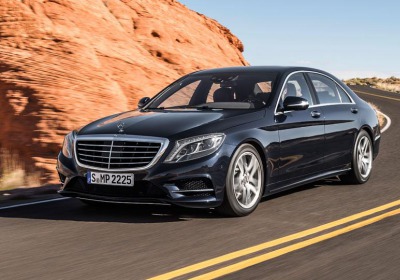2014 Mercedes-Benz S-class arrives
Wed, 15 May 2013
Mercedes-Benz has pulled the wraps off of the 2014 S-class at a media presentation in Hamburg, Germany, revealing a technological tour de force that the firm hopes will continue the plush sedan’s traditional dominance at the top of the global luxury car market.
Set to arrive in North American showrooms in September, the Mercedes-Benz flagship is charged with the task of replacing not one but two different model lines. On the one hand, it has been developed to fill the role of the previous generation S-class on sale since 2007. On the other, it has been conceived to occupy the very same territory vacated by Mercedes-Benz’s discontinued Maybach brand and its 57 and 62 sedans, which date back to 2001.
Reflecting the importance Mercedes boss Dieter Zetsche has placed on it, the new car will be available in no fewer than five different configurations: short-wheelbase sedan, long-wheelbase sedan, extra-long wheelbase sedan, coupe and cabriolet.
Stylistically, the S-class is more evolutionary than revolutionary. It shows obvious heritage in many places, but the surfacing treatment is contemporary enough to give it a modern appeal.
Continuing a trend that has seen all recent Mercedes-Benz models significantly undercut their predecessors in terms of aerodynamic efficiency, the big sedan is claimed to boast an impressively low drag coefficient of just 0.24.
Sitting proud up front is a traditional grille with added chrome, increased width and greater prominence than on any recent Mercedes model. It is just one of a number of newly interpreted design elements that helps give the S-class what Mercedes-Benz design boss Gorden Wagener describes as a “more noble visual character” than its predecessor.
Other design features of note include larger headlamps, a heavily structured front bumper, a more contoured hood complete with Mercedes-Benz’s three-pointed star emblem, less prominent wheel-arch flares and a signature dropping line along the flanks that runs from the trailing edge of the headlamps to a lower point above the rear wheel arches.
Many elements of the new S-class are developments used by its predecessor, albeit with revisions. The evolution is probably most notable in the area of electronics, where the car adopts some interesting safety features, including an illuminated belt-buckle extender and airbags within the belt straps for the rear-seat occupants. Models equipped with the optional reclining rear seat also receive an airbag within the seat cushion to prevent the occupant sliding forward in the case of an accident.
Mercedes has increased the amount of lightweight materials used in the construction of the new S-class; the entire outer skin, including the roof, is now made out of aluminum, while the internal structure uses a higher percentage of hot formed multigauge steel.
Even so, the curb weight of the S500 has risen slightly, something Mercedes attributes to a more rigid body structure.
The new S-class will begin production at Mercedes-Benz’s manufacturing headquarters in Sindelfingen, Germany with four different drivelines -- traditional gasoline, gasoline electric, diesel and diesel electric. All four will come with a seven-speed automatic gearbox from the outgoing model carrying revisions that Mercedes-Benz claims provide smoother, faster and more intuitive shifts.
Included among the drivelines planned for North American sales is an upgraded version of Mercedes-Benz’s existing twin-turbocharged 4.7-liter V8 gasoline engine that produces 20 hp more than its predecessor, for 455 hp in the S500. It will be available in standard rear-wheel drive from the outset of sales in September, with an optional all-wheel drive 4Matic model planned to see U.S. sales beginning in November.
Also slated for the U.S. is the yet-to-be-revealed S63 AMG, which will go on sale alongside the S500 4Matic in November. Like its predecessor, it is powered by a twin-turbocharged 5.5-liter V8 that is likely to offer a standard 544 hp, or 571 hp in combination with an optional performance package. Unlike the outgoing rear-wheel-drive S63 AMG, though, the new model will be sold exclusively in North America with Mercedes-Benz’s four-wheel drive 4Matic system, creating the S63 AMG 4Matic.
Other markets will receive the S400 hybrid, which uses an optimized 3.5-liter V6 gasoline unit in combination with an electric motor. Other drivelines include a carryover 3.0-liter V6 diesel engine in the S350 Bluetec and a 2.1-liter four-cylinder diesel working with an electric motor in the S300 Bluetec hybrid.
In 2014, Mercedes-Benz will introduce the S600. It will receive a revised version of the outgoing model’s twin-turbocharged 5.5-liter V12.
Also planned for launch within the next year or so is a new S500 plug-in hybrid model, which Thomas Weber, head of research and development, says achieves combined fuel consumption on the European test cycle of more than 58.8 mpg.
Heading the long list of technological advances incorporated on the new S-class is Mercedes-Benz’s so-called Magic Body Control (MBC) system. Available as an option, it uses cameras mounted within the windscreen to scan the road and detect surface irregularities before automatically adjusting the damping characteristics to reduce body movements, better control roll and pitch and generally improve overall ride comfort.
By Greg Kable

